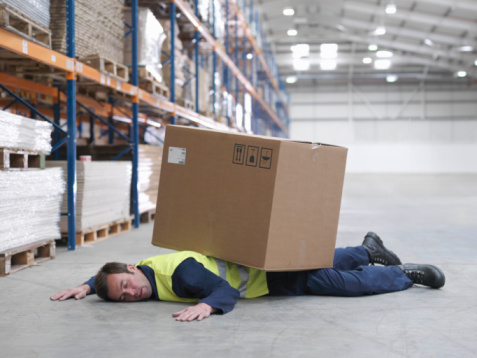They say there’s no such thing as being too careful, and when it comes to your warehouse employees, that’s doubly true. As a business owner, you are financially responsible for any injuries your employees suffer on the job, so guarding against common warehouse dangers is important not only for your employees’ health, but for your bottom line.
What follows are some of the most common warehouse dangers and what you can do to try to avoid them at your business.
Falls
Whether from height or just on the warehouse floor, falls can be the cause of injuries from minor scrapes to permanent brain damage. Here are a few guidelines for making your warehouse more fall-resistant:
- Keep it clean. Reduce the risk of trips by making sure empty boxes, packaging materials and other debris don’t collect underfoot. Spills should be cleaned up immediately as well.
- Install proper guardrails. Wherever there’s a large drop between floors, a guardrail should be installed.
- Install anti-slip floor tape.
- Eliminate unnecessary drops. Uneven flooring is a magnet for trips. Eliminate steps or ridges as much as possible, and lessen the danger of curbs by installing curb ramps.

Forklift Accidents
A forklift is one of the most useful yet most dangerous contraptions in a warehouse. Avoid forklift accidents with the following guidelines:
- Make sure all forklift drivers are properly trained and certified. Don’t let anyone else drive the forklift.
- Mark clear walkways. Avoiding collisions with workers on foot is easier if you know where those workers should be.
- As much as possible, separate foot traffic and forklift traffic.
Falling Objects
Warehouse storage units can get pretty high, which means top-shelf products, if they slip off the shelf, can pick up bone-crushing speed on their way to an employee’s head. Protect your employees from falling objects:
- Keep safe clearances down aisles. If a forklift or other machinery has to squeeze between shelves of product, you run the risk of the forklift accidentally bumping boxes off shelves. Make sure there’s enough space.
- Stack products evenly and distribute the weight properly. Whether stacked or on racks, store heavier objects near the bottom and lighter objects on top.
- Enforce any hardhat regulations. If hardhat regulations apply to your warehouse, don’t let them slip.
Delivery Truck Dangers
When a delivery truck backs up to your warehouse for loading or unloading, it presents more opportunities for accidents. Keep these guidelines in mind:
- Always be sure truck wheels are chocked.
- Turn trucks off so they aren’t pumping carbon monoxide into your loading bay.
Injuries from Lifting and Carrying
Probably the most common forms of warehouse injury stem from the strain of lifting and moving product. Make sure you teach your employees about safe lifting techniques and expect them to follow the guidelines always:
- Lift with the legs, not the back. This also applies to lowering something to the floor or onto a shelf.
- Lift only what you can carry without straining yourself. Anything heavier than that requires a helper or lifting vehicle.
- Provide back braces and back supports for employees who do the most lifting.
Accidents will happen, even though you don’t want them to — that’s why they’re called “accidents.” But by taking a thoughtful, proactive approach to safety in your warehouse, you can avoid many injuries caused by negligence or distraction.























